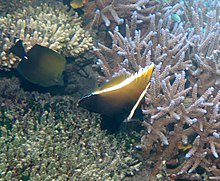Heniochus varius
| Heniochus varius | |
|---|---|

| |
| Scientific classification | |
| Domain: | Eukaryota |
| Kingdom: | Animalia |
| Phylum: | Chordata |
| Class: | Actinopterygii |
| Order: | Perciformes |
| Family: | Chaetodontidae |
| Genus: | Heniochus |
| Species: | H. varius
|
| Binomial name | |
| Heniochus varius (Cuvier, 1829)
| |
| Synonyms[2] | |
| |
Heniochus varius, the horned bannerfish or humphead bannerfish, is a species of marine ray-finned fish, a butterflyfish belonging to the family Chaetodontidae, native from the central Indo-Pacific area.
Description[edit]
The horned bannerfish is a small-sized fish that can reach a maximum length of 19 centimetres (7.5 in).[3] It has the typical deep-bodied and highly compressed body, typical of butterflyfishes.[4]
The horned bannerfish is told apart from its congeners by the adults having a pair of obvious horns on the forehead, just above the eyes and a prominent bump on the forehead.[2] The predominant colour on the body is brown to blackish broken by a thin white band behind the head and a second running from the spiny part of the dorsal fin to the caudal peduncle.[5] The two white stripes create a triangle of the base colour on the body.[6] The dorsal fin has 11 spines and 22-25 soft rays while the anal fin contains 3 spines and 17-18 soft rays.[2]
Distribution and habitat[edit]
The horned bannerfish is widespread throughout the tropical and subtropical waters of the central Indo-Pacific from Indonesia to Polynesia and from south Japan to New-Caledonia.[1][3]
It inhabits areas rich in coral in shallow lagoons and external reef slopes from the surface to a depth of 30 meters.[7]
Biology[edit]
The horned bannerfish is a solitary fish but it can live in pairs or even in small groups.[8] Its diet is varied and consists of coral polyps and various benthic invertebrates.[3]
Taxonomy[edit]
Heniochus varius was first formally described as Taurichthys varius in 1829 by the French anatomist Georges Cuvier (1769-1832) with the type locality given as Ambon Island in Indonesia.[9]
Conservation status[edit]
In some geographic areas, the horned bannerfish is occasionally harvested for the aquarium trade, however the species does not currently appear threatened is listed as Least Concern (LC) by the IUCN.[1]
References[edit]
- ^ a b c Rocha, L.A.; Allen, G.R.; Myers, R.F.; Pratchett, M. (2010). "Heniochus varius". IUCN Red List of Threatened Species. 2010: e.T165652A6081573. doi:10.2305/IUCN.UK.2010-4.RLTS.T165652A6081573.en. Retrieved 20 November 2021.
- ^ a b c Froese, Rainer; Pauly, Daniel (eds.) (2019). "Heniochus varius" in FishBase. December 2019 version.
- ^ a b c Ewald Lieske & Richard Myers (2002). Coral reef fishes. Princeton University Press. ISBN 9780691089959.
- ^ R. Pyle (2001). Kent E. Carpenter; Volker H. Niem (eds.). "CHAETODONTIDAE" (PDF). FAO Species Identification Guide for Fishery Purposes. FAO, Rome. ISBN 92-5-104302-7.
- ^ Bray, D.J. (2019). "Heniochus varius". Fishes of Australia. Museums Victoria. Retrieved 26 November 2020.
- ^ "Heniochus varius". ReefLifeSurvey. Retrieved 26 November 2020.
- ^ Allen, G.R. and M.V. Erdmann, 2012. Reef fishes of the East Indies. Perth, Australia: University of Hawai'i Press, Volumes I-III. Tropical Reef Research.
- ^ Rudie Kuiter, “Chaetodontidae & Microcanthidae”, Aquatic Photographics, 2004, ISBN 0953909735
- ^ Eschmeyer, William N.; Fricke, Ron & van der Laan, Richard (eds.). "Species in the genus Heniochus". Catalog of Fishes. California Academy of Sciences. Retrieved 26 November 2020.
External links[edit]
- Photos of Heniochus varius on Sealife Collection

